Tibet is a landlocked region in Asia.
Tibet is a landlocked region in Asia.

The Tibet Autonomous Region, officially the Xizang Autonomous Region, often shortened to Tibet or Xizang, is an autonomous region of China and is part of Southwestern China.

The Tibetan people are an East Asian ethnic group native to Tibet. Their current population is estimated to be around 6.7 million. In addition to the majority living in Tibet Autonomous Region of China, significant numbers of Tibetans live in the Chinese provinces of Gansu, Qinghai, Sichuan, and Yunnan, as well as in India, Nepal, and Bhutan.

While the Tibetan plateau has been inhabited since pre-historic times, most of Tibet's history went unrecorded until the introduction of Tibetan Buddhism around the 6th century. Tibetan texts refer to the kingdom of Zhangzhung as the precursor of later Tibetan kingdoms and the originators of the Bon religion. While mythical accounts of early rulers of the Yarlung Dynasty exist, historical accounts begin with the introduction of Buddhism from Nepal in the 6th century and the appearance of envoys from the unified Tibetan Empire in the 7th century. Following the dissolution of the empire and a period of fragmentation in the 9th-10th centuries, a Buddhist revival in the 10th–12th centuries saw the development of three of the four major schools of Tibetan Buddhism.

The official name of this Tibetan region/province is Domey, but the commonly used name is Amdo is one of the three traditional Tibetan regions, the others being U-Tsang in the west and Dotoe also known as Kham in the east. Ngari in the north-west was incorporated into Ü-Tsang. Amdo is also the birthplace of the 14th Dalai Lama. Amdo encompasses a large area from the Machu to the Drichu (Yangtze). Amdo is mostly coterminous with China's present-day Qinghai province, but also includes small portions of Sichuan and Gansu provinces.
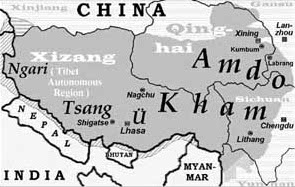
Ü-Tsang is one of the three Tibetan regions, the others being Amdo in the north-east, and Kham in the east. The region of Ngari in the north-west was incorporated into Ü-Tsang after the Tibet–Ladakh–Mughal War. Geographically Ü-Tsang covered the south-central part of the Tibetan cultural area, including the Brahmaputra River watershed. The western districts surrounding and extending past Mount Kailash are included in Ngari, and much of the vast Changtang plateau to the north. The Himalayas defined Ü-Tsang's southern border. The present Tibet Autonomous Region corresponds approximately to Ü-Tsang and the western part of Kham.

Chinese expansionism is an expansionism that has been identified with different phases of territorial expansion in Chinese history.
The Lifan Yuan was an agency in the government of the Qing dynasty of China which administered the empire's Inner Asian territories such as Mongolia and oversaw the appointments of Ambans in Tibet. Until the 1860s, it was also responsible for the Qing's relations with the Russian Empire.

The following outline is provided as an overview of and topical guide to Tibet:

The Ming dynasty considered Tibet to be part of the Western Regions. While the Ming dynasty at its height had some degree of influence in Tibet, the exact nature of their relations is under dispute by modern scholars. Analysis of the relationship is further complicated by modern political conflicts and the application of Westphalian sovereignty to a time when the concept did not exist. The Historical Status of China's Tibet, a book published by the People's Republic of China, asserts that the Ming dynasty had unquestioned sovereignty over Tibet by pointing to the Ming court's issuing of various titles to Tibetan leaders, Tibetans' full acceptance of the titles, and a renewal process for successors of these titles that involved traveling to the Ming capital. Scholars in China also argue that Tibet has been an integral part of China since the 13th century and so it was a part of the Ming Empire. However, most scholars outside China, such as Turrell V. Wylie, Melvyn C. Goldstein, and Helmut Hoffman, say that the relationship was one of suzerainty, Ming titles were only nominal, Tibet remained an independent region outside Ming control, and it simply paid tribute until the Jiajing Emperor, who ceased relations with Tibet.
The Upper Mongols, also known as the Köke Nuur Mongols or Qinghai Mongols, are ethnic Mongol people of Oirat and Khalkha origin who settled around the Qinghai Lake in so-called Upper Mongolia. As part of the Khoshut Khanate of Qaidam Basin and the Qinghai Lake, they played a major role in Sino–Mongol–Tibetan politics during the 17th and 18th centuries. The Upper Mongols adopted Tibetan dress and jewelry despite still living in the traditional Mongolian ger and writing in the script.

Tibet under Yuan rule refers to the Mongol-led Yuan dynasty's rule over Tibet from 1244 to 1354. During the Yuan dynasty rule of Tibet, the region was structurally, militarily and administratively controlled by the Mongol-led Yuan dynasty of China. In the history of Tibet, Mongol rule was established after Sakya Pandita got power in Tibet from the Mongols in 1244, following the 1240 Mongol conquest of Tibet led by the Mongol general with the title doord darkhan. It is also called the Sakya dynasty after the favored Sakya school of Tibetan Buddhism.
In 1910, Qing China sent a military force of 2,000 troops to Tibet, then a Qing protectorate, ostensibly to assert imperial authority. It led to turmoil in Tibet and caused the Dalai Lama to flee to India. It also caused a serious rupture in Sino-Tibetan relations that eventually led to Tibet's declaration of independence in 1912.
Buddhists, predominantly from India, first actively disseminated their practices in Tibet from the 6th to the 9th centuries CE. During the Era of Fragmentation, Buddhism waned in Tibet, only to rise again in the 11th century. With the Mongol invasion of Tibet and the establishment of the Mongol Yuan dynasty (1271–1368) in China, Tibetan Buddhism spread beyond Tibet to Mongolia and China. From the 14th to the 20th centuries, Tibetan Buddhism was patronized by the Chinese Ming dynasty (1368–1644) and the Manchurian Qing dynasty (1644–1912) which ruled China.

The Ganden Phodrang or Ganden Podrang was the Tibetan system of government established by the 5th Dalai Lama in 1642, after the Oirat lord Güshi Khan who founded the Khoshut Khanate conferred all temporal power on the 5th Dalai Lama in a ceremony in Shigatse in the same year. Lhasa again became the capital of Tibet, and the Ganden Phodrang operated until the 1950s. The Ganden Phodrang accepted China's Qing emperors as overlords after the 1720 expedition, and the Qing became increasingly active in governing Tibet starting in the early 18th century. After the fall of the Qing empire in 1912, the Ganden Phodrang government lasted until the 1950s, when Tibet was annexed by the People's Republic of China. During most of the time from the early Qing period until the end of Ganden Phodrang rule, a governing council known as the Kashag operated as the highest authority in the Ganden Phodrang administration.

Tibet under Qing rule refers to the Qing dynasty's rule over Tibet from 1720 to 1912. The Qing rulers incorporated Tibet into the empire along with other Inner Asia territories, although the actual extent of the Qing dynasty's control over Tibet during this period has been the subject of political debate. The Qing called Tibet a fanbu, fanbang or fanshu, which has usually been translated as "vassal", "vassal state", or "borderlands", along with areas like Xinjiang and Mongolia. Like the preceding Yuan dynasty, the Manchus of the Qing dynasty exerted military and administrative control over Tibet, while granting it a degree of political autonomy.
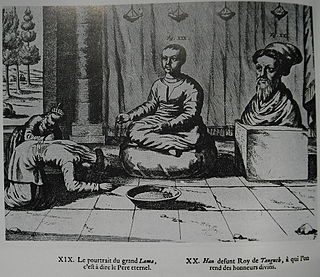
The priest and patron relationship, also written as priest-patron or cho-yon, is the Tibetan political theory that the relationship between Tibet and China referred to a symbiotic link between a spiritual leader and a lay patron, such as the historic relationship between the Dalai Lama and the Qing emperor. They were respectively spiritual teacher and lay patron rather than subject and lord. Chöyön is an abbreviation of two Tibetan words: chöney, "that which is worthy of being given gifts and alms", and yöndag, "he who gives gifts to that which is worthy".
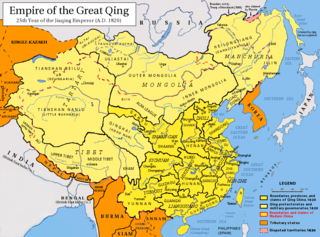
The Qing dynasty in Inner Asia was the expansion of the Qing dynasty's realm in Inner Asia in the 17th and the 18th century AD, including both Inner Mongolia and Outer Mongolia, both Manchuria and Outer Manchuria, Tibet, Qinghai and Xinjiang.
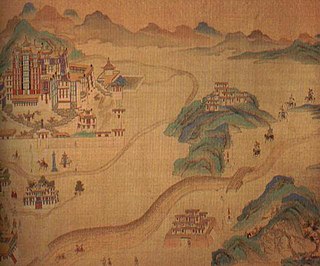
The 1720 Chinese expedition to Tibet or the Chinese conquest of Tibet in 1720 was a military expedition sent by the Qing dynasty to expel the invading forces of the Dzungar Khanate from Tibet and establish Qing rule over the region, which lasted until the empire's fall in 1912.
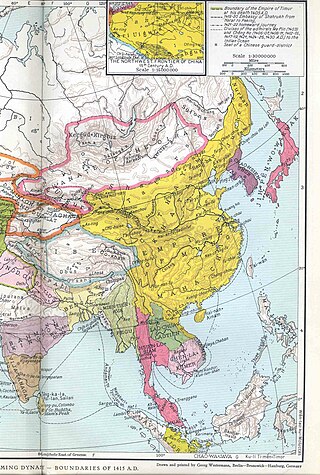
The Ming dynasty in Inner Asia was the expansion of the Ming dynasty's realm and influence in Inner Asia between the 14th and the 16th centuries. The Ming dynasty overthrew and succeeded the Mongol-led Yuan dynasty and sought to avert further incursions by a regime originating from Inner Asia. Wars were fought against the Northern Yuan, which existed as a rump state after the collapse of the Yuan dynasty in 1368, but also against other states in Inner Asia including the Oirat Confederation and Moghulistan. As a result, Ming China at the height incorporated Manchuria, much of the regions of Inner Mongolia and Qinghai, and parts of Xinjiang into its realm, and also had some degree of influence in Tibet especially during the reign of the Yongle Emperor.